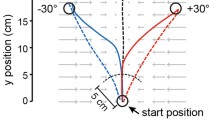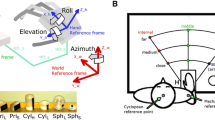Abstract
Reaching-to-grasp has generally been classified as the coordination of two separate visuomotor processes: transporting the hand to the target object and performing the grip. An alternative view has recently been formed that grasping can be explained as pointing movements performed by the digits of the hand to target positions on the object. We have previously implemented the minimum variance model of human movement as an optimal control scheme suitable for control of a robot arm reaching to a target. Here, we extend that scheme to perform grasping movements with a hand and arm model. Since the minimum variance model requires that signal-dependent noise be present on the motor commands to the actuators of the movement, our approach is to plan the reach and the grasp separately, in line with the classical view, but using the same computational model for pointing, in line with the alternative view. We show that our model successfully captures some of the key characteristics of human grasping movements, including the observations that maximum grip size increases with object size (with a slope of approximately 0.8) and that this maximum grip occurs at 60–80% of the movement time. We then use our model to analyse contributions to the digit end-point variance from the two components of the grasp (the transport and the grip). We also briefly discuss further areas of investigation that are prompted by our model.
Similar content being viewed by others
References
Biegstraaten M, Smeets JBJ, Brenner E (2003) The influence of obstacles on the speed of grasping. Exp Brain Res 149:530–534
Cruse H, Wischmeyer E, Brüwer M, Brockfield P, Dress A (1990) On the cost functions for the control of the human arm movement. Biol Cybern 62:519–528
Cuijpers RH, Smeets JBJ, Brenner E (2004) On the relation between object shape and grasping kinematics. J Neurophysiol 91:2598–2606
Fitts PM (1954) The information capacity of the human motor system in controlling the amplitude of movement. J Exp Psychol 47(6):381–391
Flash T, Hogan N (1985) The coordination of arm movements: An experimentally confirmed mathematical model. J Neurosci 5(7):1688–1703
Flash T, Sejnowski TJ (2001) Computational approaches to motor control. Curr Opin Neurobiol 11:655–662
Girgenrath M, Bock O, Jüngling S (2004) Validity of the speed-accuracy tradeoff for prehension movements. Exp Brain Res 158:415–420
Hamilton AFDC, Wolpert DM (2002) Controlling the statistics of action: obstacle avoidance. J Neurophysiol 87:2434–2440
Harris CM, Wolpert DM (1998) Signal-dependent noise determines motor planning. Nature 394:780–784
Jeannerod M (1981) Intersegmental coordination during reaching at natural visual objects. In: Long J, Baddeley A (eds) Attention and performance IX, pp 153–169
Jeannerod M (1984) The timing of natural prehension movements. J Motor Behav 16:235–254
Kamper DG, Cruz EG, Siegel MP (2003) Stereotypical fingertip trajectories during grasp. J Neurophys 90:3702–3710
Kudoh N, Hattori M, Numata N, Maruyama K (1997) An analysis of spatiotemporal variability during prehension movements: effects of object size and distance. Exp Brain Res 117:457–464
Loeb GE, Levine W, He J (1990) Understanding sensorimotor feedback through optimal control. Symp Quant Biol 55:791–803
Luo Z, Svinin M, Ohta K, Odashima T, Hosoe S (2004) On optimality of human arm movements. In: Proceedings of the IEEE international conference on robotics and biomimetics 2004, pp 447–452
MacKenzie IS (1995) Movement time prediction in human-computer interfaces. In: Baecker RM, Buxton WAS, Grudin J, Greenberg S (eds) 2nd edn. Readings in human-computer interaction, pp 483–493
Meulenbroek RGJ, Rosenbaum DA, Jansen C, Vaughan J, Vogt S (2001) Multijoint grasping movements – simulated and observed effects of object location, object size, and initial aperture. Exp Brain Res 138:219–234
Miyamoto H, Wolpert DM, Kawato M (2003) Computing the optimal trajectory of arm movement: The TOPS (Task optimization in the presence of signal-dependent noise) model. In: Dura RJ, Santos J, Grana M (eds). Biologically inspired robot behaviour engineering, vol 109. Studies in fuzziness and soft computing, Chapt 14. Springer, Berlin Heidelberg New York, pp 395–416
Miyamoto H, Nakano E, Wolpert DM, Kawato M (2004) TOPS (Task optimization in the presence of signal-dependent noise) model. Syst Comput Japan 35(11):48–58
Mon-Williams M, Tresilian JR, Coppard VL, Carson RG (2001) The effect of obstacle position on reach-to-grasp movements. Exp Brain Res 137:497–501
Morasso P (1981) Spatial control of arm movements. Exp Brain Res 42:223–227
Oztop E, Arbib MA (2001) A biologically inspired learning to grasp system. In: Proceedings of the 23rd annual EMBS international conference, IEEE, pp 857–860
Schettino LF, Adamovich SV, Poizner H (2003) Effects of object shape and visual feedback on hand configuration during grasping. Exp Brain Res 151:158–166
Simmons G, Demiris Y (2004) Biologically inspired optimal robot arm control with signal-dependent noise. In: Proceedings of the 2004 IEEE/RSJ international conference on intelligent robots and systems, vol 1. pp 491–496
Simmons G, Demiris Y (2005) Optimal robot arm control using the minimum variance model. J Robot Syst (11):677–690
Smeets JBJ, Brenner E (1999) A new view on grasping. Motor Control 3:237–271
Timmann D, Stelmach GE, Bloedel JR (1996). Grasping component alterations and limb transport. Exp Brain Res 108:486–492
Uno Y, Kawato M, Suzuki R (1989) Formation and control of optimal trajectory in human multijoint arm movement: Minimum torque-change model. Biol Cybern 61:89–101
Author information
Authors and Affiliations
Corresponding author
Rights and permissions
About this article
Cite this article
Simmons, G., Demiris, Y. Object Grasping using the Minimum Variance Model. Biol Cybern 94, 393–407 (2006). https://doi.org/10.1007/s00422-006-0053-0
Received:
Accepted:
Published:
Issue Date:
DOI: https://doi.org/10.1007/s00422-006-0053-0




